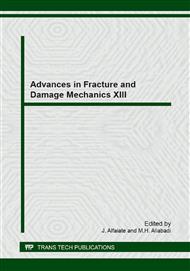[1]
ASTM International Standard E399-06 (2006) Standard test method for linear-elastic method of plane-strain fracture toughness KIC of metallic materials, pp.1-32.
DOI: 10.1520/e0399-08
Google Scholar
[2]
Červenka Consulting, s. r. o. – http://www.cervenka.cz
Google Scholar
[3]
T., Holušová, S., Seitl, A., Fernández-Canteli, Comparison of fracture energy values obtained from 3PB, WST and CT test configurations, Special Issue of Advanced Material Research. (2014).
DOI: 10.4028/www.scientific.net/amr.969.89
Google Scholar
[4]
T., Holušová, S., Seitl, A., Fernández-Canteli, Modified compact tension test: The influence of the steel bars position, IC of Engineering Mechanics (2014)
Google Scholar
[5]
B. L., Karihaloo, Fracture mechanics of concrete, Longman Scientific & Technical, New York. (1995)
Google Scholar
[6]
M. K., Lee, B. I. G., Barr, An overview of the fatigue behavior of plain and fibre reinforced concrete. Cement & Concrete Composites, Vol. 26, (2004) pp.299-305.
DOI: 10.1016/s0958-9465(02)00139-7
Google Scholar
[7]
D., Pryl, J., Červenka, R., Pukl, Material model for finite element modelling of fatigue crack growth in concrete. Procedia engineering, Vol. 2, (2010) pp.203-212.
DOI: 10.1016/j.proeng.2010.03.022
Google Scholar
[8]
RILEM Report 5 Fracture Mechanics Test Methods for Concrete (S. P. Shah & A. Carpinteri eds.), Chapman and Hall, London (1991).
Google Scholar
[9]
RILEM TC-50 FMC Recommendation Determination of the fracture energy of mortar and concrete by means of three-point bend test on notched beams, Materials & Structures (1985).
DOI: 10.1007/bf02498757
Google Scholar
[10]
S., Seitl, H., Šimonová, Z., Keršner, A., Fernández-Canteli, Evaluation of concrete fatigue measurement using standard and non-linear regression model. Applied Mechanics and Materials, Vol. 121−126, (2012) pp.2726-2729.
DOI: 10.4028/www.scientific.net/amm.121-126.2726
Google Scholar
[11]
D., Pryl, J., Mikolaskova, R., Pukl, Modeling fatigue damage of concrete, Key Engineering Materials, V. 577-578, (2014) pp.385-388
DOI: 10.4028/www.scientific.net/kem.577-578.385
Google Scholar
[12]
H., Šimonová, B., Kucharczyková, I., Havlíková, S., Seitl, Z., Keršner, Complex evaluation of fatigue tests results of plain C30/37 and C45/45 class concrete specimens, Key Engineering Materials, V. 592-593, (2014) pp.801-804
DOI: 10.4028/www.scientific.net/kem.592-593.801
Google Scholar


